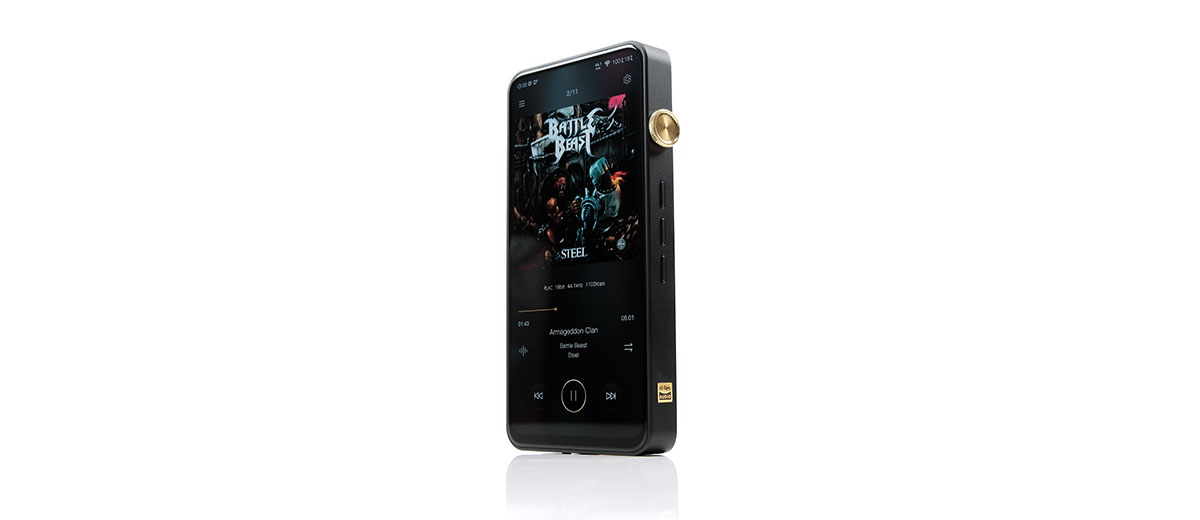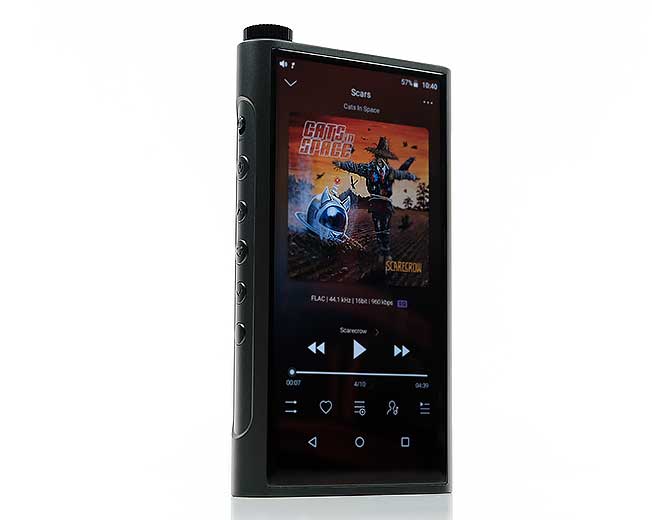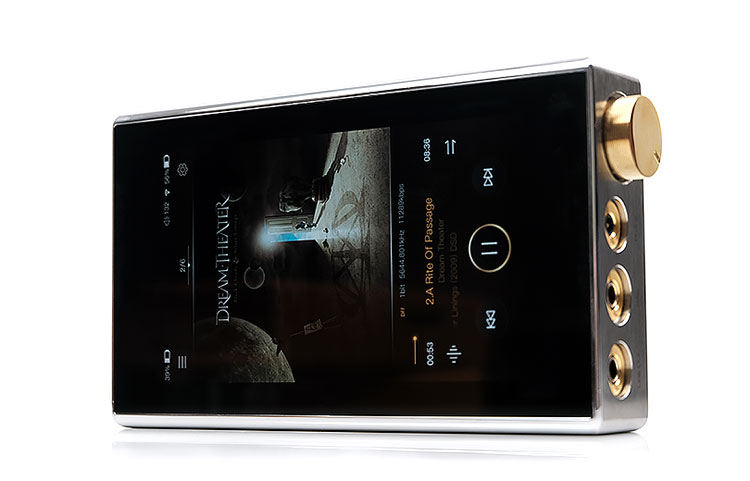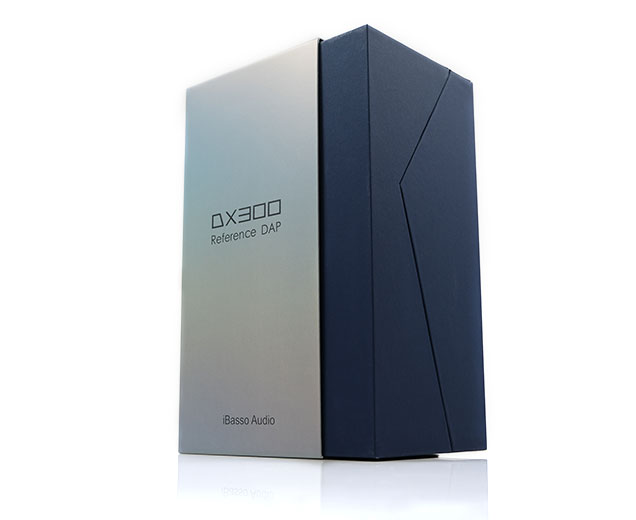Select Comparisons
FiiO M15
$1299
Technical
The M15 is FiiO’s flagship DAP from 2020 and got a pretty good score from us also. At the time this was the fastest DAP out in the market, it is now the 3rd fastest behind the R8 and yes now the DX300. How time flies in the tech world.
Inside, it packs a dual AKM AK4499EQ DAC implementation compared to the DX300’s quad CS43198 design. Both chipsets are flagship-level but how sustainable the M15 production line is after the AKM factory fire is anyone’s guess.
Both can decode or natively unfold MQA up to X8 for a full hi-res 24BIT/384K for playback. However, the M15 is a little bit more future-proofed for hi-res codecs at 768kHz/32bit and native DSD512 support compared to 32BIT/384kHz and DSD256 on the DX300.
The DX300 AMP11 has an edge for pure amplification grunt with 1240mW into 32Ω balanced compared to 800mW from the M15. However, on the SE side, the M15 is rated just below 500mW with a similar load whereas the DX300 AMP11 drops to 350mW. Both offer 3 output options in PO and LO also with 3.5mm TRS, 2.5mm TRRS, and 4.4mm Pentaconn.
Internally, the Samsung Exynos 7872 inside the M15 is very fast but time has moved on with the DX300’s Snapdragon 600 and double the RAM at 6GB compared to 3GB measuring twice as fast as the FiiO on AnTuTu.
No question the DX300 has the advantage here with Android 9 and the Mango Dual boot OS framework compared to the M15’s Android 7 single OS design. Android 7 is already EOL as of December 2020 so future application compatibility is in question.
Design
The M15 is relatively big but pales in comparison to the DX300 dimensions. The key factor in this is the beautiful 6.5″ IPS panel on the DX300. Not only is it bigger than the 5.15″ IPS panel on the M15 but has a higher resolution than the FiiO 720p screen and a stronger pixel density.
The M15 is like a large DAP with a great screen, the DX300 handles more like a good quality smartphone with its screen and it makes a huge difference in terms of browsing.
However, despite the bigger form factor, the weight of the DX300 is lighter by 10g at 300g compared to 310geach so iBasso has done very well indeed to keep the DX300 away from Sony 1Z territory.
What I would say is that some of the M15 design cues are a little bit better. The physical buttons are on the left side and less susceptible to accidental activation, especially with a physical lock button.
The analog volume control at the top is a little more integrated also and feels better quality than the Dx300 rotary dial. The DX300 dial does multi-function which can be an advantage for quick rebooting but it lacks the depth and customization of the M15 multi-function button.
The DX300 offers the bigger onboard memory at 128GB compared to just 64GB and both have only a single microSD slot. Battery management is not separated like the DX300 but its large 7300mAh battery will give you a similar rating to the DX300 of 15 hours.
Performance
We tested 2 monitors to tease out the difference in these two DAPs, namely the feisty v-shaped Empire Ears Hero and the more forgiving Andromeda 2020. The first thing we noted was the noise floor differences with the Andromeda 2020 hooked up. The DX300 has a far blacker background than the M15 with sensitive gear.
The DX300 is also comparatively smooth or natural to neutral in both timbre and staging whereas the M15 is a little cleaner with a bit more mids to treble bias in both timbre and presence.
With the Andromeda 2020, the DX300 upper mids and treble sound ‘calmer’ less prone to harmonic dissonance in higher-pitched vocal overtones. Whereas the M15 shoots for more vocal forwardness so it has more energy here but also sounds a bit sharper, more prone to natural sibilant emphasis.
Treble is where the M15 has more presence and perceived information coming through. The DX300 sounds relatively relaxed here with more of a natural fade. Hi-fidelity spatial cues high in the upper registers of the M15 are more forceful with a bit more shine and bite.
Neither are overly emphasized on the very low-end and not as warm or full-bodied as the R8. However, the DX300 has a bit more warmth through the mid-bass, upper bass, and mids compared to the M15.
This works better for me when using the V-shaped Hero which sounds a little more balanced and not as delicate through the mids. The M15 will emphasize that V-shape a bit more drawing you into the top and bottom of the FR for energy whereas the DX300 does a better job of opening up the mids and creating a bit more space.
iBasso DX220 MAX
$1888
Technically a Limited Edition design but it represents the pinnacle of the 200 Series DAPs though barely a DAP in terms of size and portability.
Power Management
Inside, the DX200 MAX shared a similar split topology to the DX300 in terms of one power supply to a digital side and another to the analog side. However, the battery packs used by the DX220 MAX are much bigger with 5 individual li-poly batteries, 1 (3.8V 4400mAh) for digital, and 4 (4 x 900mAh 8.4V) for the amplifier.
The DX300 battery management is a single 4000 mAh 3.8V lithium-ion polymer battery for the digital side and a smaller 2000 mAh 3.8V lithium-ion polymer battery for the amplifier. Despite the differences, both are quite close in overall battery life at 14 hours for the MAX and 15 hours for the DX300.
The biggest drawback of the MAX power management is the DC input for charging the analog amplifier side. That means a wall wart and far less portability compared to the quick charging DX300 single USB-C port.
DAC
The DAC inside the DX220 MAX is really the DX220, no change there with a dual ES9028PRO implementation, Penta-femtosecond level oscillation, and the older Arm Cortex CPU and no FPGA implementation. The DX300’s CS43198 is a relative sidegrade for me on its own but closed the gap with a quad-chip implementation.
There are some pros and cons in terms of decoding from the different chipsets. The MAX will offer a higher DSD512 decoding rate compared to DSD256 on the DX300 but both will top out for PCM at 32BIT/384kHz.
The DX300 handles MQA unfolding to X8 which is double the MAX X4 rate so potentially a superior device for hi-res streaming via TIDAL. Both are bit-perfect at a system-wide level for decoding.
Amplifier
On a Vrms level, the DX220 MAX has a bit more power at 4.4Vrms SE and 8.8 VRMS balanced but I would expect that given its original design intent. It does not use amp cards so that might change with future DX300 card launches. Both units offer LO via 4.4mm, however, the MAX uses a dedicated 3.5mm TRS LO whereas the DX300 is a shared output through a true LO.
Design
The one comparison where the DX300 becomes featherweight compared to the heavyweight MAX. At 700g, the MAX is over twice the weight of the DX300 and also twice the height and a shade wider. The DX300 is the taller of the two with a higher resolution 6.5″ IPS panel compared to the stubbier legacy DX220 5″ panel inside the MAX.
The ‘aged’ CNC stainless steel body of the MAX complete with the gold trims of the analog pot and jack ports just up the ante in terms of attractive aesthetics. The DX300 is a bit more subdued in looks, the rotary dial, whilst also gold is on the tacky side of gold for me.
The bigger emphasis for the DX300 is to draw you into the beautiful screen, whereas the MAX design is more of a tiny desktop theme in terms of overall looks.
Both rock a 128GB onboard memory with a single microSD slot with WiFi and Bluetooth connectivity. However, in terms of external features such as physical control buttons, the MAX has precious few aside from the power button. That makes working with the OS much more of a pure touchscreen experience compared to the DX300’s more complete control system.
As for the OS? No question the faster Snapdragon 600 combined with Android 9 and the updated Mango OS wins the day here for the DX300. It makes the MAX seem very slow in comparison.
Performance
It is awfully hard to beat the DX220 MAX in terms of technical ability, and though the DX300 is officially their new flagship, the MAX is still an exceptional sounding player.
However, the MAX is a different sounding player to the DX300 with a timbre that is a little drier and more decidedly solid-state in both energy and articulation. The dynamic range is a little bit better for me on the MAX as also the level of instrumental separation including perceived treble presence and extension.
If you want a technical masterpiece and a supremely black background then this is it because the MAX resolving capability is world-class.
The DX300 wisely opts for timbre over reference and in doing so it’s not more of the same in a new suit. The timbre is warmer, wetter, more liquid in the attack. The body is also fuller and warmer in the lower-mids. Vocals have a broader texture and a sweeter overtone and the low-end offers a bit more quantity and rumble.
You can tell iBasso really tuned the DX300 to be a ‘listeners’ DAP as it is the more forgiving of the two players. I guess you can call it a grab for some character in the sound, something which Cayin has always tried to inject into their own DAP range.
HiBy R8
$1899
Despite the jump in price this comparison seems to be a popular request. The R8 was our Top Gear award winner from 2020 with a number of features that put them well ahead of the competition.
Technical
Inside, the R8 uses a dual AK4497EQ DAC implementation completed with an FPGA/DSP set up as well a similar Snapdragon 660 CPU as the DX300. The DX300 switches to a quad CS43198 design balanced design and adds an additional 2GB (6GB total) over the HiBy R8.
AnTuTu results are very similar with a level of speed and processing power that both can rightly claim to be the best in the DAP market today, (see Page 2 for performance data).
The decoding capability though is slightly different and here the R8 has an edge with a native DSD512 and PCM 32BIT/768kHz ceiling as well as MQA 16X native unfolding. The DX300 drops down to 32BIT/384kHz for PCM and DSD256 as well as MQA 8X.
Both offer BT5.0 with a maximum LDAC decoding rate though if you have a HiBy dongle you can opt for their proprietary UAT codec which, though less stable, transmits at a higher data rate.
In terms of amplification, the DX300 AMP11 card has a slight advantage at a 32Ω load for balanced output at 1240mW compared to the Turbo mode setting of the R8 balanced output at 1088mW.
Note, the R8 amplification stage is fixed, whereas the DX300 uses an amp card system and AMP11 is a discreet design compared to the custom opamp design of the R8 amp stage. Output impedance is lower on the DX300 for both balanced and SE though both are under 1Ω. Balanced LO has a bit more headroom on the DX300 at 7.1Vrms compared to 4.1Vrms on the R8.
Design
The R8 is thicker, heavier, but shorter in length. The R8 weighs in at 446g which is 146g more than the DX300 and you can feel that difference in your hand. The stubbier size of the R8 though maybe more suitable for smaller hands.
One thing to note is the placement and action of the physical buttons on the R8. They are on the same side as the DX300 but a little higher and stiffer. The DX300 buttons seem more prone to accidental button pushing when being picked up.
As a volume dial, I prefer the R8 alps pot implementation as it feels more integrated and protected from accidental bumps. However, it does lack the multi-function capability of the DX300 rotary dial.
The screen on the DX300 is a step up from the R8 at 6.5″ vs 5.5″, with less bezel, and a higher resolution. The DX300 screen’s higher pixel density at 396ppi compared to 320ppi on the R8 also makes fonts more legible at extreme angles.
Battery specs from the huge 10000mAh battery inside the R8 are few and far between but I do seem to get a fairly competitive 11-12 hours out of it without too much task usage. The DX300 is close, perhaps marginally better in similar conditions, however, this is not a scientific measurement so take it with a grain of salt.
Both have solid connectivity with WiFi and BT5.0 though onboard memory is half at 64GB on the R8 compared to 128GB on the DX300. Both use Android 9.0, though HiBy has no dual boot alternative OS. The two DAPs have bitperfect architecture system-wide with killer features such as iBasso’s PMEQ and HiBy’s MSEB.
Performance
These two DAPs are closer in terms of general tonal signature than I expected them to be with both aiming for a smooth natural tone over precise analytical performances. However, there are a number of differences when paired with the Andromeda 2020 and the Ara, for example, that might push preferences one way or another.
The R8 has a bit more sub-bass ‘bounce’ and you can hear that in kick drum and bass synth fundamentals. It is not a huge weight difference but it just tips the lower-pitching instrumental timbre closer to the lower order whereas the DX300 kept it middling.
The DX300 has good depth but it’s more linear to mid-bass and upper mids so its fundamental is a tiny bit lighter but it also sounds punchier and fuller through to the midrange. I always felt the mids of the R8 to be ‘juicy and smooth’ but compared to the DX300 it actually sounded a little more neutral and cleaner.
The DX300 vocals have a broader note, a bit more texture, and an attack that is quite liquid without being overly soft. It also sounds a bit more forward with more perceived stereo width whereas the R8 delivered a soundstage deep but a little more center-focus on the mids.
I did detect the R8 offering a bit more treble detail with a slight mid-treble emphasis though nothing like the M15. It is relatively relaxed to the M15 but more elevated than the DX300 which takes the place of the R8 as having the most SET-like tone of the two. You can hear that elevation in tiny cues such as hi-hat percussion and drier rimshots.
Our Verdict
I honestly think the DX300 is a bit of a bargain for what it offers given the current pricing for DAPs in 2021. This is a flagship DAP with a crazy good modern smartphone-like design, wonderful display, and a much-improved interface with Android 9. It is fast, responsive, and so very easy to work with.
It is not all roses though and I do have some quibbles. Ditch that stock case for a start, its loose fit is an accident waiting to happen so grip it tightly at all times in case your precious DX300 drops out. The physical control buttons are all too easy to accidentally press and the rotary volume dial has a strange aesthetical detachment from the otherwise low-profile chassis.
However, the DX300 sound quality is going to surprise quite a few and for me, it’s a welcome change because it speaks more about character, soul, and enjoyment of listening.
This is a natural tone, a tube-like quality yet still with a very black background. It is easier on the ear with beautiful texture in both instruments and vocals as well as excellent staging to flesh it out properly.
In some ways, I almost feel like the iBasso team are coming out of their shell a bit more with the DX300. Despite the top-notch specs, the sound is less about the technical prowess and more about the emotional quality of what you hear. That has got to be a good thing in my books.
iBasso DX300 Specifications
- Color: star blue/obsidian black
- Body material: aluminum alloy
- Display: 6.5″ IPS screen, 2340*1080 resolution, with in-cell capacitive touch screen
- Audio format: MQA, APE, FLAC, WAV, WMA, ACC, ALAC, ISO, M3U, M3U8
- USB connection method: Type-C USB3.1 (high-speed data transmission and fast charging)
- Output: 2.5mm/4.4mm balanced headphone output, 3.5 mm single-ended headphone output; 2.5 mm/3.5mm/4.4mm linear output; 3.5mm coaxial output
- WiFi: 802.11b/g/n/ac (2.4 Ghz/5Ghz) 2×2 MIMO 5G WiFi
- Bluetooth: V5.0
- Storage: 6g Ram, 128G Rom, expandable Mirco SD (TF) card slot
- Battery: 4000 mAh 3.8V lithium-ion polymer battery + 2000 mAh 3.8V lithium ion polymer battery
- Charging time: about 2.5 hours
- Playing time: up to 15 hours
- Size: about 162 mm * 77 mm * 17 mm
- Weight: about 300 grams
4.4mm/ 2.5mm balanced headphone output
- Maximum output level: 7.1 Vrms
- Output power: 1240mW@32ohm, 168mW@300ohm
- Frequency response: 10Hz~40kHz +/-0.3dB
- Signal to noise ratio: 125dB
- Dynamic range: -125dB
- THD+N: -113dB (no Load, 3Vrms) / -109dB (300R Load) / -101dB (32R Load)
- Resolution: -120dB
- Impedance: 0.39ohm
3.5mm single-ended headphone output
- Maximum output level: 3.5 Vrms
- Output power: 350mW@32ohm, 34mW@300ohm
- Frequency response: 10Hz~40kHz +/-0.3dB
- Signal to noise ratio: 123dB
- Dynamic range: -123dB
- THD+N: -111dB (no Load, 3Vrms) / -107dB (300R Load) / -95dB (32R Load)
- Resolution: -103dB
- Impedance: 0.43ohm
4.4 mm/ 2.5 mm Balanced Line Out
- Maximum output level: 7.1 Vrms
- Frequency response: 10Hz~40kHz +/-0.3dB
- Signal to noise ratio: 125dB
- Dynamic range: -125dB
- THD+N: -111dB (no Load, 3Vrms)
- Resolution: -113dB
3.5 mm single-ended Line Out
- Maximum output level: 3.5 Vrms
- Frequency response: 10Hz~40kHz +/-0.3dB
- Signal to noise ratio: 123dB
- Dynamic range: -123dB
- THD+N: -111dB (no Load, 3Vrms)
- Resolution: -103dB






